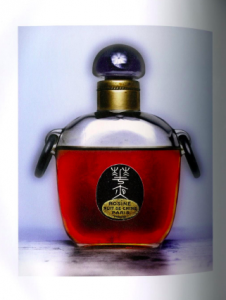In the exhibit, Empire of Signs, at the Metropolitan Museum of Art in New York City the impact of Chinese art, culture and general aesthetics on Western art and fashion was presented. The thesis was that Chinese aesthetics have driven “fashionable imagination” in Western countries for decades. In this exhibit, enigmatic objects, bodies and spaces were explored and shown to audiences. Enigmatic means: difficult to understand, mysterious. The items presented in the exhibit show this influence both as an enigmatic concept, and enigmatically.
One of the categories of the exhibit Empire of Signs, was Enigmatic Objects. It is here the image of a bottle of perfume is seen.

Les Parfums de Rosine (French 1911). “Nuit de Chine” perfume flacon.
This bottle of perfume is from a french company founded in 1911. The fragrance is called “Nuit de Chine”, or Night in China/Chinese Night. For the reason that the perfume is called “Night in China” alone, it represents an enigmatic space. The bottle represented a capitalization of the appeal of mystery the Orient held for Europeans in the early 1900s. The scent symbolized for consumers the appeal of a location they might never visit, but that was “exotic” and shrouded in mystery. It would make them, the wearer, mysterious and exotic, desirable, out of reach. For researchers, the perfume symbolizes a location that is neither in the imagination of a French parfuemerier, nor in a busy Chinese city at night. It is both a location that is nowhere, and is in both places.
good claim: “Night in China” as enigmatic space
This image itself is enigmatic as well. The perfume bottle has a label on it with what appears to be a false Chinese symbol. The label is meant to be uninterpretable, mysterious. It is not meant to be understood by users, nor taken seriously. The French words say the name of the brand, Rosine, and the name of the scent. The dark colored perfume, coupled with the simplistic brass handles on either end are intended to mimic popular European depictions of China. The entire bottle, its simplicity, its vague label, its name are all intended to promote an enigmatic space of China.
the bottle, the label, and the scent created “enigmatic space of China”: the claim is appealing which calls for explanation/support, however.
